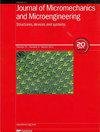Micromachining of nickel and nickel-based alloy surfaces using composite signal
IF 2.1
4区 工程技术
Q2 ENGINEERING, ELECTRICAL & ELECTRONIC
引用次数: 0
Abstract
Abstract Electrochemical micromachining refers an unconventional technology in the field of machining. With this technology, the ultrashort pulse power supplies are extensively used to address the issue of excessive machining of non-processing areas. However, the reduction of pulse duration is the only effective strategy to enhance the processing accuracy in ultra-short pulse electrochemical microfabrication. Nonetheless, the high cost of equipment and unsuitability in practical production has limited its progress. To resolve this issue, this paper proposes the use of a composite signal in electrochemical micromachining instead of ultrashort pulses. By changing the signal waveform during machining, the energy required for processing can be reduced with the same electromotive force input, thereby reducing the current used to decompose the anode in the circuit and effectively improving machining accuracy. This approach was employed to manufacture micro-structures on a pure nickel sheet, achieving micron-scale accuracy. Moreover, the same level of superior machining accuracy can be achieved when machining micro-structures on hard-to-cut super alloy plates.基于复合信号的镍及镍基合金表面微加工
电化学微加工是机械加工领域的一项非常规技术。利用该技术,超短脉冲电源被广泛用于解决非加工区域的过度加工问题。然而,在超短脉冲电化学微加工中,缩短脉冲时间是提高加工精度的唯一有效策略。但设备成本高,在实际生产中不适用,限制了其发展。为了解决这一问题,本文提出在电化学微加工中使用复合信号代替超短脉冲。通过改变加工过程中的信号波形,可以在相同电动势输入的情况下减少加工所需的能量,从而减少电路中用于分解阳极的电流,有效提高加工精度。这种方法被用于在纯镍片上制造微结构,达到微米级的精度。此外,在难以切割的超级合金板上加工微结构时,也可以达到同样的优越加工精度。
本文章由计算机程序翻译,如有差异,请以英文原文为准。
求助全文
约1分钟内获得全文
求助全文
来源期刊

Journal of Micromechanics and Microengineering
工程技术-材料科学:综合
CiteScore
4.50
自引率
4.30%
发文量
136
审稿时长
2.8 months
期刊介绍:
Journal of Micromechanics and Microengineering (JMM) primarily covers experimental work, however relevant modelling papers are considered where supported by experimental data.
The journal is focussed on all aspects of:
-nano- and micro- mechanical systems
-nano- and micro- electomechanical systems
-nano- and micro- electrical and mechatronic systems
-nano- and micro- engineering
-nano- and micro- scale science
Please note that we do not publish materials papers with no obvious application or link to nano- or micro-engineering.
Below are some examples of the topics that are included within the scope of the journal:
-MEMS and NEMS:
Including sensors, optical MEMS/NEMS, RF MEMS/NEMS, etc.
-Fabrication techniques and manufacturing:
Including micromachining, etching, lithography, deposition, patterning, self-assembly, 3d printing, inkjet printing.
-Packaging and Integration technologies.
-Materials, testing, and reliability.
-Micro- and nano-fluidics:
Including optofluidics, acoustofluidics, droplets, microreactors, organ-on-a-chip.
-Lab-on-a-chip and micro- and nano-total analysis systems.
-Biomedical systems and devices:
Including bio MEMS, biosensors, assays, organ-on-a-chip, drug delivery, cells, biointerfaces.
-Energy and power:
Including power MEMS/NEMS, energy harvesters, actuators, microbatteries.
-Electronics:
Including flexible electronics, wearable electronics, interface electronics.
-Optical systems.
-Robotics.
 求助内容:
求助内容: 应助结果提醒方式:
应助结果提醒方式:


